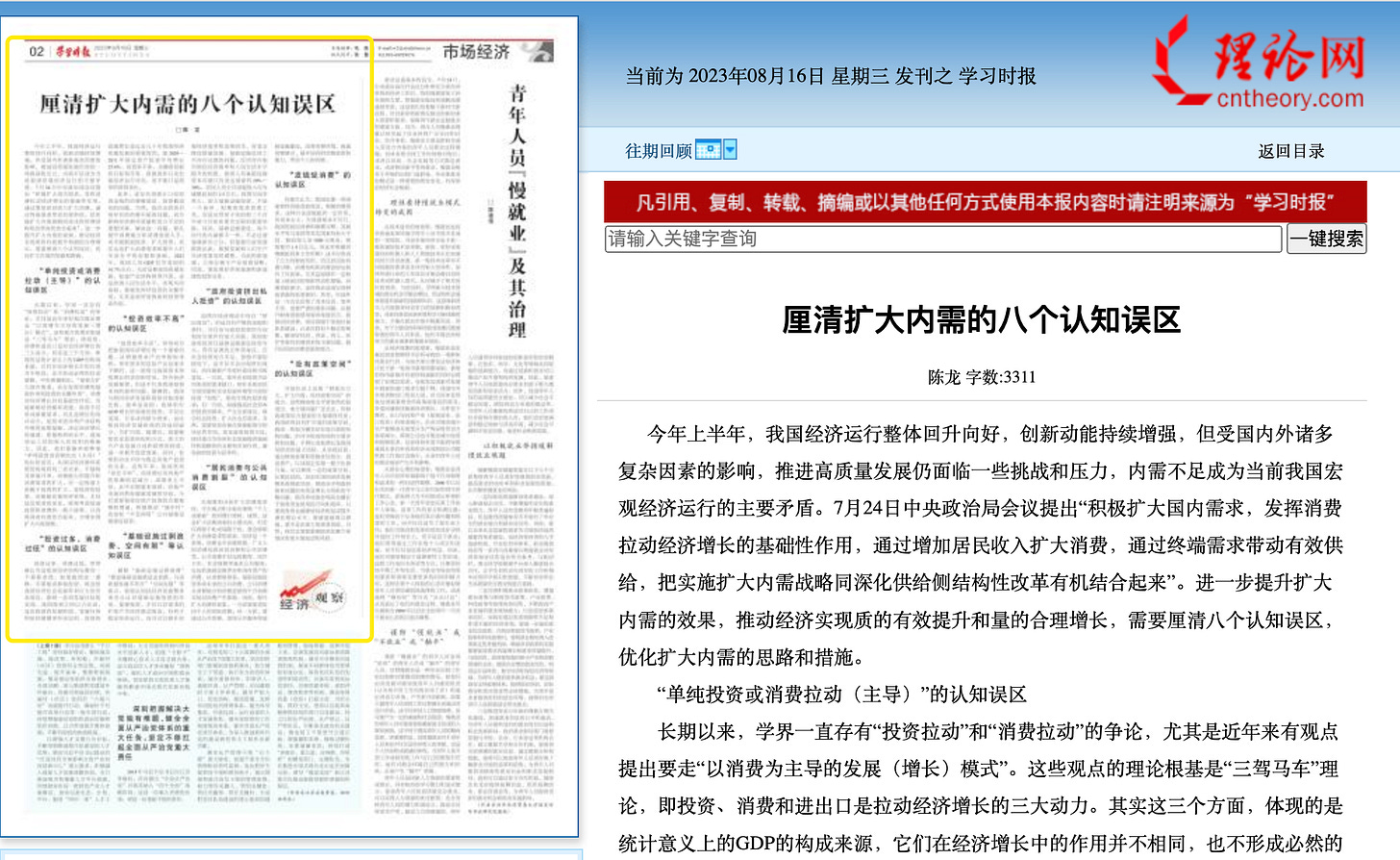Study Times op-ed shoots down new policy options
Central Party School newspaper op-ed says cash handouts won't work, there's no over-investment & they are not inefficient, more infrastructure to build, & govt is not crowding out private investment.
The 学习时报 Study Times, the official newspaper of the Central Party School (the Communist Party of China’s highest internal training institution), published an op-ed on Wednesday, August 16, which basically shot down many if not all new policy options presented by economists at financial institutions and more market-oriented academics.
To be clear, it is not an editorial - typically understood as reflecting the media outlet’s official position - and Study Times is not exactly the People’s Daily. The author is given as Chen Long, a very common male name, with no description of his background. Some have pointed out that there is a person bearing working at the Chinese Academy of Fiscal Sciences under the Ministry of Finance.
Regardless of whether someone is sending a faint signal, the piece is a pretty representative summary of the status quo view and that’s why I’m sharing it. For the new policy advice this op-ed argued against, read the linked posts at the end.
厘清扩大内需的八个认知误区
Unraveling Eight Misconceptions About Expanding Domestic Demand
In the first half of this year, the overall performance of China's economy has been on the upswing, with innovation continuing to gain momentum. However, challenges and pressures still remain in achieving high-quality development due to complex domestic and international factors. The principal contradiction in China’s current macroeconomic operation lies in insufficient domestic demand.
On July 24, the meeting of the Political Bureau of the Central Committee of the Communist Party of China (CPC) emphasized the need to "actively expand domestic demand and leverage the fundamental role of consumption in driving economic growth. By increasing personal income to expand consumption, and by stimulating effective supply through consumer demand, implementing the strategy of expanding domestic demand should be organically integrated with deepening the supply-side structural reform." To further enhance the effects of expanding domestic demand and promote both qualitative and quantitative growth in the economy, it is imperative to address eight misconceptions and optimize the approach and measures for expanding domestic demand.
The misconception about 'solely relying on investment or consumption-driven development models'
For a long time, debate in academia has centered on "investment-driven" versus "consumption-driven" development models, especially in recent years when some argue for a development model predominantly led by consumption. The theoretical foundation of these views is the "three engines" growth theory, which posits investment, consumption, and imports/exports as the three main drivers of economic growth. However, these are merely three components of GDP measured by the “expenditure approach”. Their roles differ in terms of economic growth and do not necessarily lead to economic growth. The Central Committee of the CPC has clearly pointed out the need to "focus on expanding domestic demand and fully leverage the fundamental role of consumption and the critical role of investment." Consumption plays a foundational role in economic growth, directly influencing the quality of economic circulation. Investment not only forms short-term demand but is also the real driving force behind growth. It is the foundation for technological advancement and industrial structure upgrades, determining the rate, quality, and supply level of economic growth, and in turn, people's income and purchasing power.
Thus, it is necessary to abandon the misconception of relying solely on "investment or consumption-driven development models". Their relationship must be viewed from the circular flow perspective and not in isolation. The increase of people’s spending power and the expansion of consumer demand are, to some extent, contingent upon increased investment and are indeed outcomes of such investments. Depending on the macroeconomic conditions, especially changes in aggregate demand, a package of detailed policy measures should be implemented to promote both investment and consumption. Only by effectively integrating the two can the strategy of expanding domestic demand be realized.
The Misconception of 'Over-Investment and Under-Consumption'
Excessive investment paired with low consumption is often perceived as a significant sign of China’s economic structural imbalance. Following this line of thought, undervaluing or curbing investment could bring massive negative impacts on China's socio-economic development, hindering several developmental goals. China’s high investment share is determined by its developmental stage, developmental tasks, and the personal savings rate. Rapid growth in investment has been a crucial factor behind China's speedy economic development over the past decades, as evidenced by the annual growth rate of 25.6% in fixed-asset investment between 2003 and 2011. Whether over-investment exists depends on the development objectives and tasks, resource conditions, and macroeconomic performance, rather than simple comparison across countries.
Furthermore, there's the issue of underestimating consumption and overestimating investment due to disparities in statistical caliber. Indeed, sluggish consumption, which has become a critical factor affecting the quality and vitality of the circular flow of the economy, is an issue. Addressing this requires efforts to boost consumer purchasing power and willingness to pay, rather than restricting investment. Expanding investment is, in essence, a prerequisite and foundation for increasing consumption demand and improving living standards. In 2022, China's GDP per capita was only around 16.7% of that of the United States. Whether advancing high-quality development, promoting industrial transformation and upgrading, or improving the people's living standards to achieve common prosperity, the critical role of investment, especially the driving role of government investment, must be emphasized.
Misconception of "Low Investment Efficiency"
"Low investment efficiency" frequently emerges as a critical concern embedded in China's economic growth. The incremental capital output ratio (i.e., the relationship between the level of investment and the consequent increase in GDP) shows the marginal output per unit of capital is gradually declining. This trend corresponds with China's continual capital growth and aligns with economic development patterns. However, this doesn't necessarily indicate an inherent efficiency issue with China’s investments. According to measurements, China’s efficiency is relatively high compared with other nations at the same developmental stage. The investment required for each unit of GDP growth in China is not only significantly less than that of the US, Japan, or Western Europe but also less than other nations at a similar stage of economic development.
To expand domestic demand and ensure steady growth, it is vital to continue to refine China’s investment mix and approach, increase investments in line with directions and trends of industry development, and thereby enhance the effect of investment. Meanwhile, it's crucial to balance the principle of "houses are for living in, not for speculation" with maintaining stable real estate investments. In recent years, China is acting on the principle that "houses are for living in, not for speculation", and has markedly reduced economic reliance on real estate – a hard-won achievement indeed. In the medium-to-long term, the real estate market still holds potential for healthy development. In the future, it's essential to maintain a reasonable scale and growth rate in real estate investments and actively promote investments in slum reconstruction and the “dual-use for normal and emergency” public infrastructure. (The “dual-use” infrastructure guidelines were approved for building public infrastructure for both normal and emergency use in megacities, as part of the efforts to support the economy and cope with future public health crises.)
The misconception of "Infrastructure Overcapacity and Limited Space"
To debunk views such as "infrastructure overcapacity is wasteful," "promoting infrastructure equates to taking the old path that's inconsistent with high-quality development," and "limited space," it's crucial to fully understand the role of infrastructure investment from a holistic perspective of national economic development. Infrastructure investment doesn't only interact with the expansion of aggregate demand to stabilize economic operations, but also enhances macroeconomic efficiency, improves people's living standards, and robustly supports high-quality development. Overall, there's no issue of excessive infrastructure. On the contrary, there are areas that hinder the efficiency of the national economy and the improvement of people's living standards. China’s per capita infrastructure capital stock only accounts for 20% to 30% of the developed countries, and public facility investments per rural resident are only about a fifth of an urban dweller, indicating potential for investment.
Stepping up efforts in infrastructure investment isn't just a temporary, short-term tool for demand management but a key measure that should run throughout the realization of the CPC's Second Centenary Goal [building China into a great modern socialist country in all respects]. Furthermore, the connotation of infrastructure construction varies with each era, so there is no need to overemphasize the distinction between old and new. However, the content of infrastructure does need timely adjustments based on developmental needs and people's evolving lifestyles. Presently, most of the new infrastructure projects fall under the category of industrial investments. Hence, it's essential to balance the investment relationship between traditional and new infrastructure projects.
The Misconception of the "Government Investment Crowding Out Private Investment"
In economic theory, the concept of a "crowding-out effect" exists, suggesting that rising public sector spending drives down or even eliminates private sector spending. However, it's crucial to recognize that this idea is based on specific assumptions and conditions. Moreover, it is closely related to government investment directions and circumstances of the time. In China, the primary focus of government investment is on infrastructure development, which notably generates positive externalities. With lack of private impetus and willingness for investment, no crowding-out effect arises, but compensatory and induced effects can be observed. (Induced effects measure the value of additional economic demands that the direct firms or institutions place on supplying industries in the region.) On one hand, this compensates for the investment gap caused by insufficient corporate investments, addressing areas such as the people’s wellbeing and the environment for private enterprises, ensuring reasonable investment demand. On the other hand, it indirectly elevates the rate of return on investment for non-governmental capital, attracting more non-governmental investments and boosting aggregate demand. Of course, it's imperative to uphold the decisive role of the market in resource allocation. The direction of government investment must be to primarily provide foundational and strategic support and guidance for economic and social development while sidestepping conflicts between government investments and private interests.
The Misconception of ‘Decoupling Household and Public Consumption
When assessing the expansion of consumer demand, many viewpoints are heavily focused on individual or household consumption. While undeniably a significant aspect of increasing consumption demand, solely concentrating on this dimension could hamper the overall effect. The economy operates as a system, and consumption shouldn't be fragmented. Broadly speaking, consumption includes both household consumption and public consumption. Public consumption encompasses not only basic public services like education, healthcare, and social welfare but also the use of tangible state-owned assets, such as infrastructure. In terms of consumption, investment in infrastructure paves the way for future public consumption, which influences household purchasing power and willingness to consume. Therefore, to amplify the effect of increased consumption, we must do more than bolster individuals’ actual consumption. It's also essential to enhance the consumption environment, eliminate the bottlenecks in consumption, boost residents' willingness and ability to consume, and drive up household consumption by accelerating public services and infrastructure development,
The Misconception of 'Cash Handouts to Boost Consumption’
Some argue that China should directly disburse cash to stimulate consumer demand like some countries have done. Although this approach may offer some benefits, its costs are exorbitant, rendering it unfeasible in China’s context. The patterns of consumption and savings, and the level of development in China significantly differ from developed nations like the United States. For instance, a cash handout of 1,000 yuan per person would require about 1.4 trillion yuan. But what tangible impact would this have on stimulating consumption? Such a strategy would not only impose a vast fiscal burden, but also have limited effect due to residents' consumption habits, consumption patterns, and willingness to consume. Especially as the pandemic has heightened precautionary motives and given rise to more conservative consumption behavior, this could inevitably lead to inefficient use of valuable fiscal resources. In fact, overseas implementations of this method have also faced issues like high costs, inefficiency, and severe waste. To truly elevate the efficiency of fiscal resource utilization and encourage consumer spending, the focus should be on strengthening the social welfare system. By establishing stable expectations for the public and addressing core issues like housing, retirement, child-rearing, and healthcare, the consumption willingness and ability of households can be better elevated.
The Misconception of 'No Policy Space'
Recently, a prevailing sentiment suggests that due to immense fiscal pressures and the need to expand domestic demand, there's "no policy space" available. While the large discrepancy between government revenues and expenditures, and local-government debt issues are drawing concerns, the focus on enhancing the intensity and effectiveness of fiscal policy remains unchanged. China still possesses the policy space to stimulate domestic demand. Admittedly, some regions in China grapple with structural local debt issues. However, these do not embody the primary economic contradiction and concerns. No growth or low growth are the most significant risks China should guard against. In practice, certain policy space can be unlocked by optimizing fiscal policies and grouping of resources, revitalizing assets, and implementing a package of detailed policy measures to resolve debt. In theory, one must view the fiscal latitude from the overall perspective of national economic development. The crux of fiscal deficits and government debt lies in the balance between growth and risk. The pivotal determinant of debt risk revolves around the direction and efficiency of debt fund usage. As long as the debt capital can contribute to economic recovery or elevate the potential growth level, significant debt risks will not emerge because the revenue foundation has been reinforced. That said, it is also imperative to address and mitigate the liquidity risks associated with local debts in specific regions. (Enditem)
Prominent economist calls for stimulating consumption & shunning excessive investment
A group of prominent Chinese economists called for the government to stimulate consumption instead of sticking to investment-led growth on November 19 at the CMF宏观经济热点问题研讨会(第57期)57th Seminar on Hot Topics in the Macroeconomy of the China Macroeconomic Forum (CMF).
Leading professor calls for massive govt subsidy to families at key forum
Zhang Jun is Distinguish Professor of Humanities and Social Sciences, Dean of the School of Economics, and Director of the Research Institute of Chinese Economy at Fudan University. He delivered a keynote speech titled 让中国家庭有更稳定的消费能力 "Enable Chinese Families More Stable Spending Power" in the 拓展消费新场景 "Exploring New Consumption Scenes" session of the 经济峰会…
Economist calls on Beijing to shift from investment to boosting consumer spending
A group of prominent Chinese economists called for the government to stimulate consumption instead of sticking to investment-led growth on November 19 at the CMF宏观经济热点问题研讨会(第57期)57th Seminar on Hot Topics in the Macroeconomy of the China Macroeconomic Forum (CMF).
Zhang Jun: low wages threaten China's ecoomic transition, govt needs to subsidize familes
Zhang Jun is Distinguish Professor of Humanities and Social Sciences, Dean of the School of Economics, and Director of the Research Institute of Chinese Economy at Fudan University. Pekingnology has shared insights from him before, and today is sharing his recent speech at the 2023










